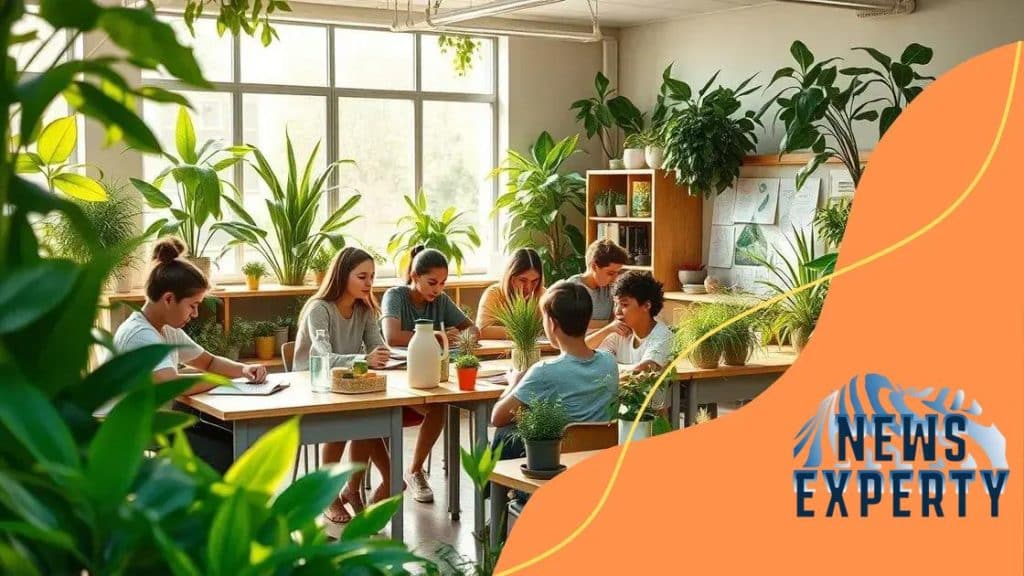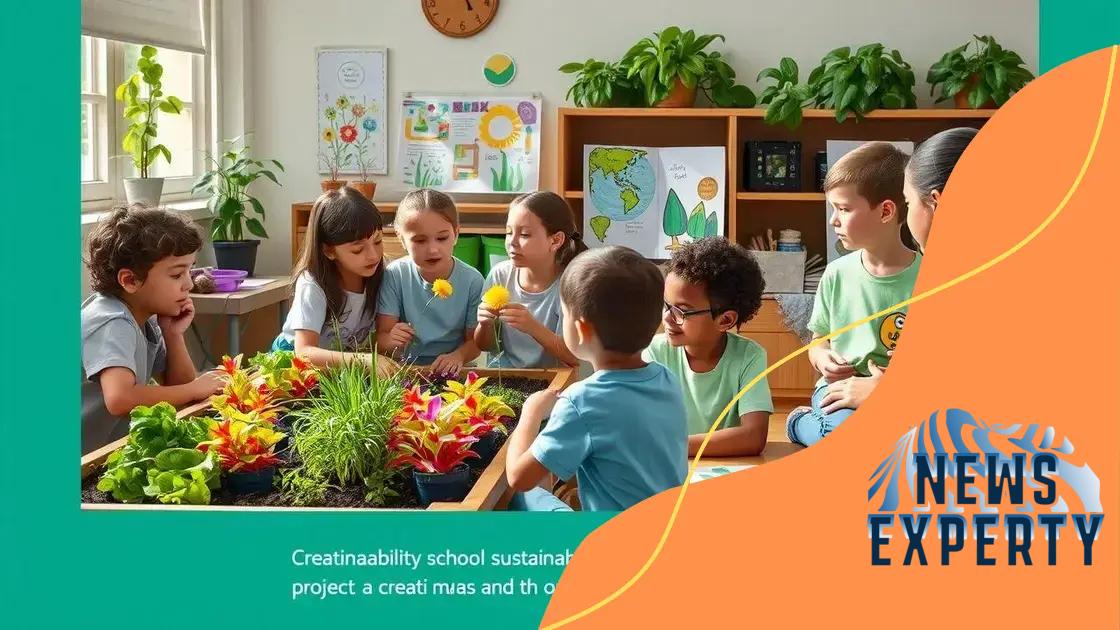How to incorporate sustainability into school curricula

Anúncios
Incorporating sustainability into school curricula enhances students’ critical thinking, fosters environmental awareness, and engages them in real-world applications through hands-on projects and community involvement.
How to incorporate sustainability into school curricula is a question more educators are exploring today. By weaving sustainability into lessons, we can foster environmental awareness and inspire future generations. Curious how it can impact your school? Let’s dive in.
Anúncios
Understanding sustainability in education
Understanding sustainability in education is crucial for nurturing environmentally conscious citizens. When schools incorporate sustainability into their curricula, they empower students to think critically about their impact on the planet. This integration invites students to explore real-world issues, enhancing their learning experience.
What is Sustainability?
Sustainability refers to practices that meet current needs without compromising future generations’ ability to meet theirs. In education, this means teaching students about environmental stewardship, social responsibility, and economic viability. Incorporating sustainability can inspire students to take action.
Key Concepts to Teach
Here are some essential concepts to consider when introducing sustainability education:
Anúncios
- Resource conservation: Teach students about the importance of conserving resources like water and energy.
- Climate change awareness: Help them understand the effects of climate change and how to mitigate it.
- Sustainable practices: Introduce daily practices they can adopt, such as recycling and composting.
Sustainability education goes beyond textbooks; it can take on various forms. For instance, hands-on projects can engage students in meaningful ways. By growing a school garden, students can learn about food systems and biodiversity while developing teamwork skills.
Field trips to local farms or recycling centers can also provide practical lessons. These experiences can spark initial interest and motivate students to pursue sustainable practices. Bring in community speakers to share their efforts in sustainability. This will create a bridge between classroom learning and real-world application.
It’s important to make sustainability education relatable. Use local examples that resonate with students’ lives. Discuss how their choices impact the local environment and community. The more personal the connection, the more they will engage with the material.
Overall, understanding sustainability in education is about making learning relevant and inspiring. By approaching this topic through various methods, we can prepare students to become environmentally responsible adults.
Key benefits of integrating sustainability
Integrating sustainability into education brings numerous benefits that can enrich students’ learning experiences. It not only promotes environmental consciousness but also develops essential skills in students.
Enhanced Critical Thinking
By exploring sustainability topics, students learn to analyze complex issues. They become adept at considering various perspectives and making informed decisions. This critical thinking skill is vital in today’s world.
Real-World Application
When students engage with sustainability, they see the real-world implications of their actions. Understanding concepts like carbon footprints and waste management helps them connect classroom learning to everyday life. This link between theory and practice increases retention of knowledge.
- Improved Collaboration: Sustainability projects often involve group work, which enhances teamwork and communication skills.
- Greater Engagement: Students are more motivated when they see the relevance of their studies to global challenges.
- Community Involvement: Integrating sustainability can foster partnerships with local organizations, expanding learning beyond school walls.
Another benefit is increased awareness of global issues. Students who study sustainability grasp the urgency of challenges like climate change and biodiversity loss. They are more prepared to address these challenges as informed citizens.
Furthermore, sustainability initiatives can cultivate a sense of agency. Students feel empowered when they learn they can make a difference in their communities. Whether through recycling programs or advocacy campaigns, their contributions matter.
Lastly, integrating sustainability can have positive effects on school culture. Schools that prioritize sustainability create a healthier environment. Green spaces and eco-friendly practices contribute to a sense of well-being among students and staff.
Creative ways to teach sustainability

Teaching sustainability creatively can captivate students’ interests and deepen their understanding. When educators use innovative methods, they create memorable experiences that inspire real change.
Hands-On Projects
One effective approach is through hands-on projects. For example, starting a school garden allows students to learn about ecosystems and food systems actively. They can plant vegetables, take care of the plants, and understand the importance of local food sources. This experiential learning makes concepts tangible.
Art Integration
Another creative method is to integrate art into sustainability lessons. Students can create posters, sculptures, or murals that express environmental themes. This not only enhances their creativity but also reinforces their understanding of important issues like climate change or conservation.
- Collaborative Learning: Engaging students in group projects helps foster teamwork and communication.
- Field Trips: Visiting local parks, recycling centers, or farms connects classroom learning to the real world.
- Guest Speakers: Bringing in local environmentalists can inspire students and provide expert insights.
Incorporating technology is another effective way to teach sustainability. Virtual reality experiences can immerse students in different environments, showing the impact of pollution or deforestation. Online collaboration platforms allow students to engage in global discussions about sustainability, enhancing their understanding of global interconnectedness.
Interactive games and simulations also serve as engaging tools. For example, sustainability-themed video games can challenge students to manage resources efficiently, making them aware of the consequences of their decisions. This approach encourages critical thinking and problem-solving.
Furthermore, integrating sustainability into existing subjects can be a creative way to reinforce lessons. In science, students can study renewable energy sources. In social studies, they can analyze policies that impact the environment. These connections help students see the relevance of sustainability across multiple disciplines.
Challenges in implementing sustainability topics
Implementing sustainability topics in school curricula comes with several challenges. Educators must navigate various obstacles to ensure effective teaching and encourage student engagement.
Lack of Resources
One significant challenge is the lack of resources. Many schools may struggle to allocate funds for sustainable materials or training. Without proper resources, educators may find it difficult to create engaging lessons. Many teachers are eager to incorporate sustainability, but they may feel limited by inadequate supplies.
Curriculum Constraints
Another challenge includes existing curriculum constraints. Educators face pressure to meet standardized testing requirements, which can leave little room for additional topics like sustainability. This rigid structure can hinder innovative teaching.
- Time Limitations: Educators often have limited classroom time to cover the required subjects while integrating new topics.
- Administrative Support: Lack of support from school administration can make it hard to prioritize sustainability.
- Teacher Training: Many teachers may not feel confident in their understanding of sustainability, making professional development vital.
Additionally, student interest can fluctuate. Some students may not see the relevance of sustainability to their lives. To counteract this, educators need to find ways to connect lessons to students’ experiences. Making topics relatable is essential for engagement.
Moreover, achieving consensus on how to address sustainability can be difficult. Different viewpoints and beliefs about environmental issues can create disagreements among faculty and parents. To implement sustainability successfully, schools must foster collaboration and open dialogue.
Lastly, changing perceptions and building a culture of sustainability takes time. Schools often have established practices that may resist change. Implementing new strategies requires patience and persistence to shift mindsets towards sustainability.
Success stories of schools making a difference
There are inspiring success stories from schools that are effectively integrating sustainability into their curricula. These examples show how dedicated efforts can create positive changes in both students and the community.
Case Study: Green School
One example is the Green School in Bali, Indonesia. This unique school is built with bamboo and emphasizes environmental education. Students engage in hands-on projects focused on ecology and sustainable living. They learn about composting, gardening, and renewable energy. This practical approach empowers students to understand their role in protecting the environment.
Community Partnerships
Another success story comes from an urban school in New York City. This school partnered with local organizations to create a rooftop garden. Students help maintain the garden, learning about growing food while also studying nutrition. The project connects them to their community and promotes healthy eating habits. It’s a win-win situation where both education and community wellness thrive.
- Reduce, Reuse, Recycle Programs: Many schools implement these programs to encourage sustainable practices among students.
- Environmental Clubs: Students lead initiatives that address local environmental issues, fostering leadership skills.
- Curriculum Integration: Successful schools connect sustainability with science, social studies, and even art.
In another instance, a school in California introduced a water conservation campaign. They educated students on the importance of saving water and conducted projects like rainwater harvesting. By involving the students directly, they not only learned valuable lessons but also became advocates for sustainability in their homes.
These success stories highlight the diverse ways schools are making a difference. They showcase the importance of creativity, collaboration, and commitment to sustainability. Each initiative demonstrates that when schools integrate sustainability topics, students are inspired to become future stewards of the planet.
Incorporating sustainability into school curricula is vital for shaping the future of our planet. Through hands-on projects, community involvement, and innovative teaching methods, schools can inspire students to become environmentally responsible citizens. Success stories from various schools demonstrate that even simple initiatives can have a profound impact. With creativity and commitment, educators can equip the next generation with the tools they need to address global challenges and foster a more sustainable world.
FAQ – Frequently Asked Questions about Incorporating Sustainability in Education
What are some effective ways to teach sustainability in schools?
Hands-on projects, integration of art, and community partnerships are excellent methods to teach sustainability creatively.
How does sustainability education benefit students?
It enhances critical thinking, promotes real-world application, and fosters environmental awareness among students.
What challenges do schools face when implementing sustainability topics?
Common challenges include lack of resources, curriculum constraints, and varying levels of student interest.
Can you share examples of successful sustainability initiatives in schools?
Yes, successful examples include school gardens, rooftop gardens, and water conservation campaigns that engage students actively.





